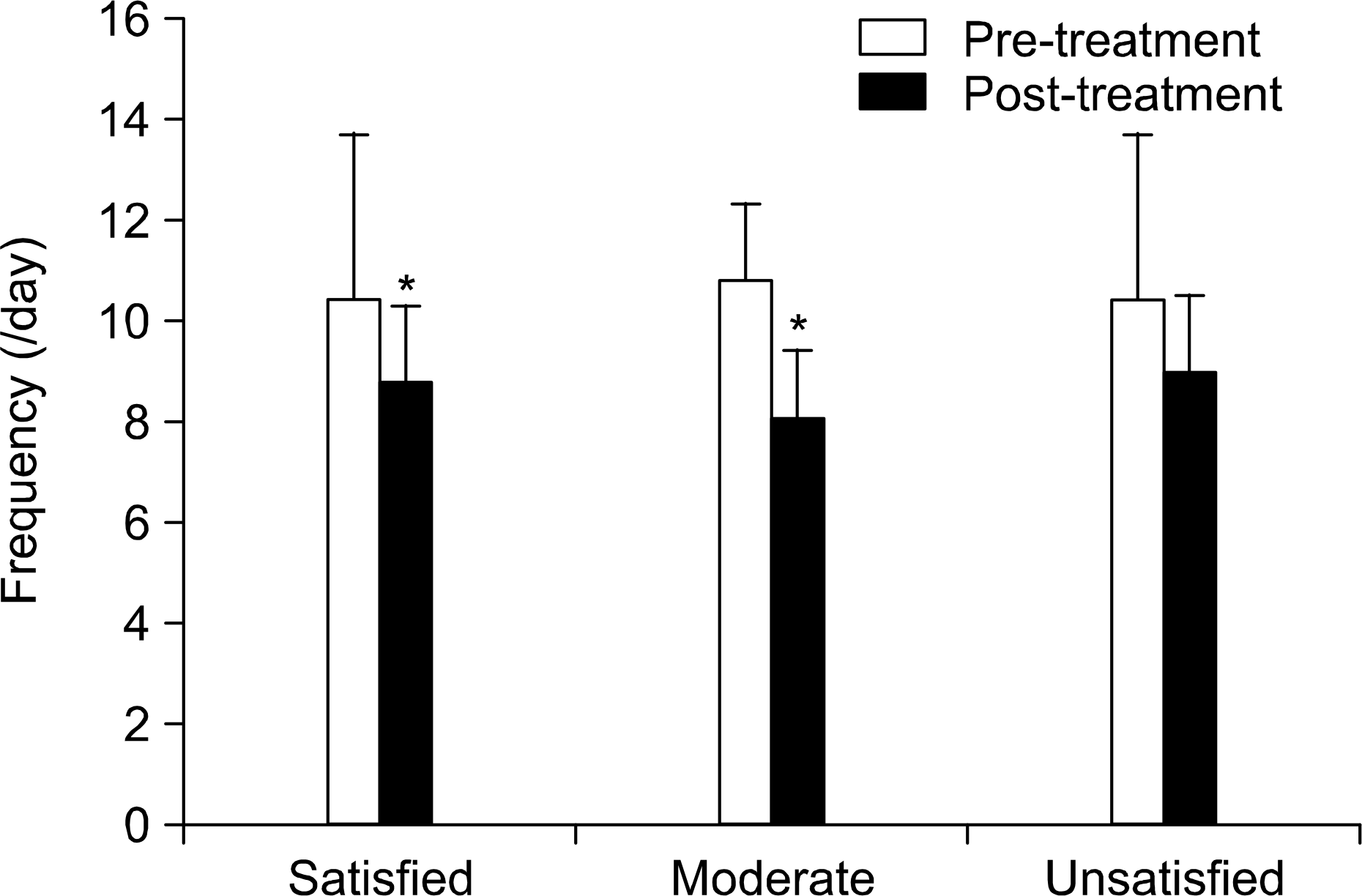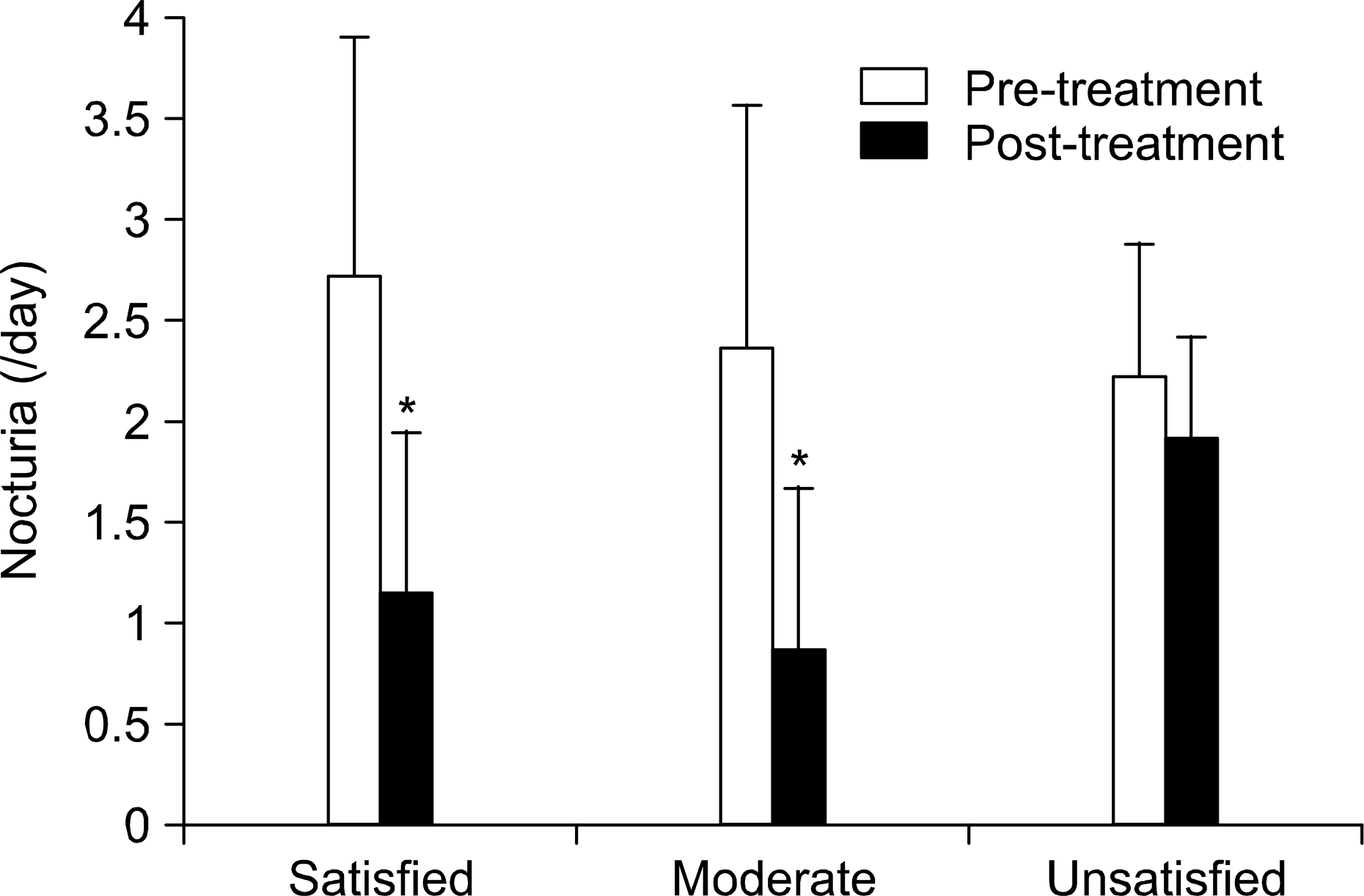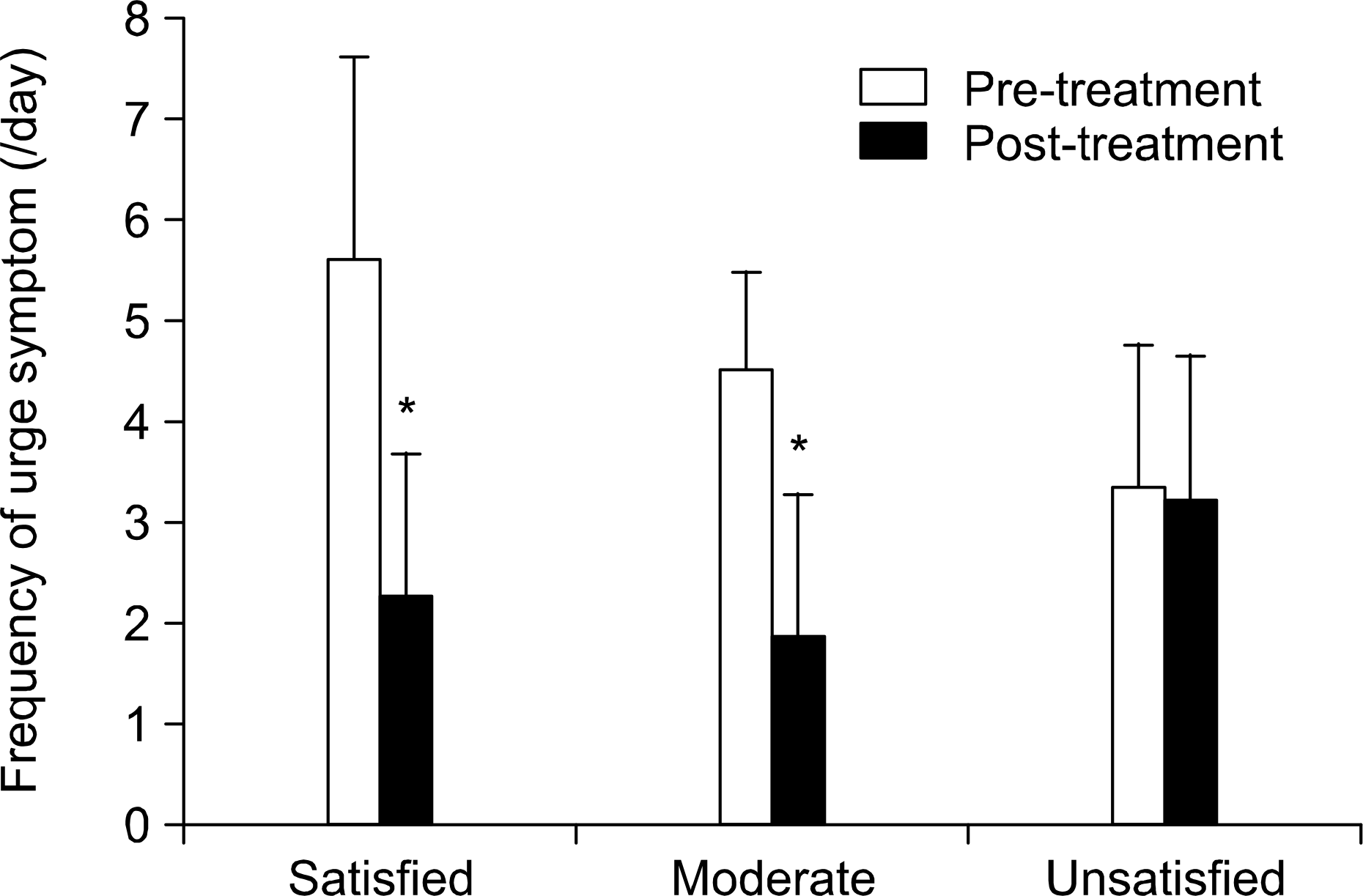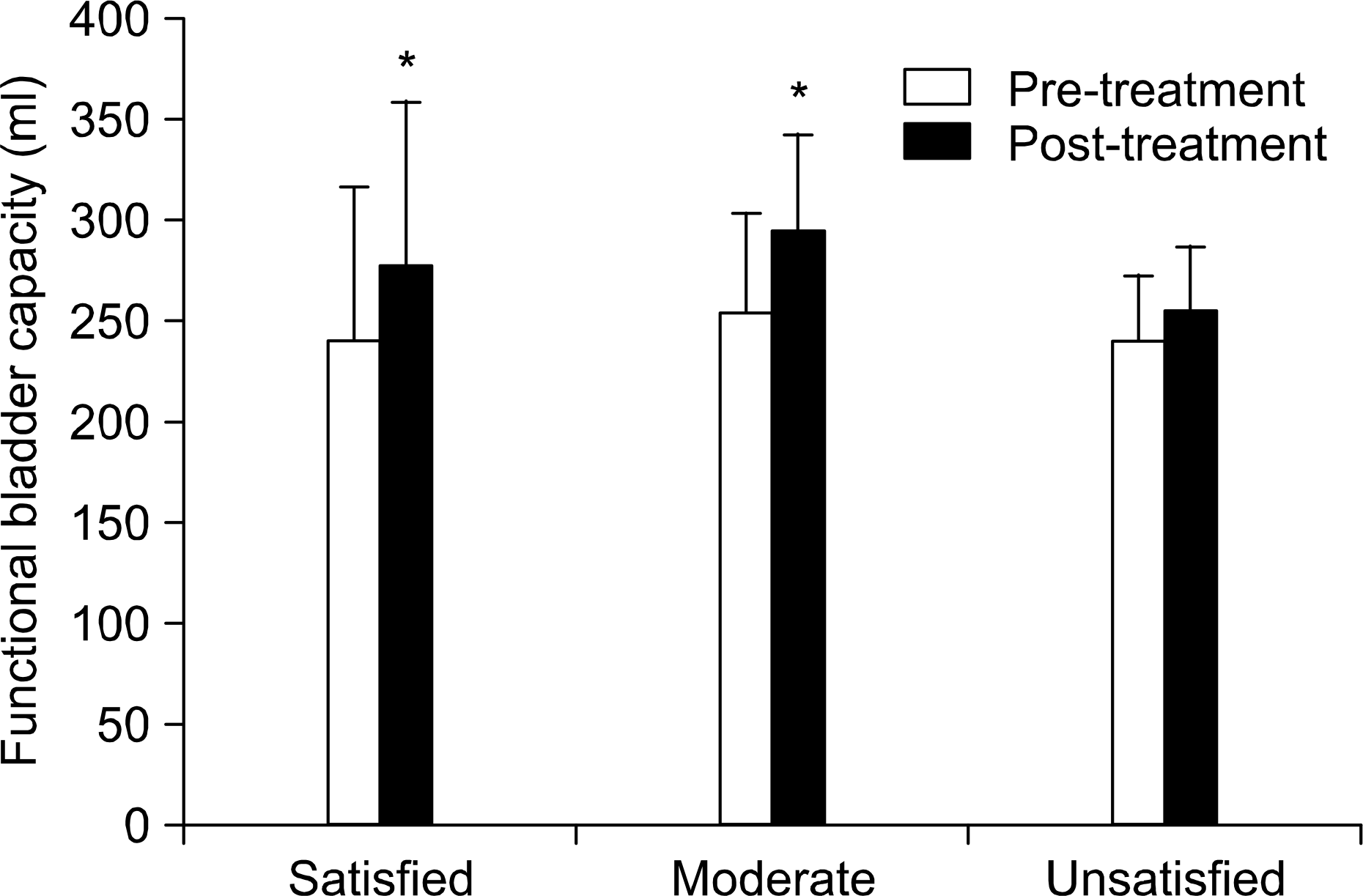Abstract
Purpose:
To analyze the predictors of the antimuscarinic treatment response for female patients with an overactive bladder (OAB).
Materials and Methods:
Eighty women diagnosed with an OAB, who had also undergone 3 months of treatment with propiverine hydrochloride (20mg/day), were enrolled. All patients were assessed by history taking, physical examination, urinalysis, frequency/volume charts and urody- namic study (UDS) prior to treatment; frequency/volume charts and a patients’ satisfaction were analyzed 3 months after treatment. Patients were divided into satisfied, moderate and unsatisfied groups according to their subjective satisfaction.
Results:
Subgroups according to the patients’ subjective satisfaction included 57, 14 and 9 patients for satisfied, moderate and unsatisfied group, respectively. In the UDS, detrusor overactivity was noted in 15 patients of the satisfied group, 2 of the moderate group, but none of the unsatisfied group. Maximum detrusor pressure and detrusor pressure at maximum flow were higher in the unsatisfied group. The incidence of bladder outlet obstruction (BOO) was higher in the moderate and unsatisfied groups. In pre-treatment frequency/volume chart, the frequency of urge symptom was significantly increased in the satisfied group. Comparing the pre- and post-treatment frequency/volume charts revealed that the satisfied and moderate groups showed decreased frequency and nocturia, and increased functional bladder capacity compared to unsatisfied group after treatment.
REFERENCES
2.Temml C., Heidler S., Ponholzer A., Madersbacher S. Prevalence of the overactive bladder syndrome by applying the International Continence Society definition. Eur Urol. 2005. 48:622–7.

3.Yoshimura N., Chancellor MB. Current and future pharmacological treatment for overactive bladder. J Urol. 2002. 168:1897–913.

4.Madersbacher H., Murtz G. E伴icacy, tolerability and safety profile of propiverine in the treatment of the overactive bladder (non-neurogenic and neurogenic). World J Urol. 2001. 19:324–35.
5.Kreder K., Mayne C., Jonas U. Long-term safety, tolerability and efficacy of extended-release tolterodine in the treatment of overactive bladder Eur Urol. 2002. 41:588–95.
6.Andersson KE. Antimuscarinics for treatment of overactive bladder Lancet Neurol. 2004. 3:46–53.
7.Blaivas JG., Groutz A. Bladder outlet obstruction nomogram for women with lower urinary tract symptomatology. Neur-ourol Urodyn. 2000. 19:553–64.

8.Abrams P., Larsson G., Chappie C., Wein AJ. Factors involved in the success of antimuscarinic treatment. BJU Int. 1999. 83(Suppl 2):42–7.

9.Igawa Y. Discussion: functional role of Ml, M2, M3, and M3 muscarinic receptors in overactive bladder. Urology. 2000. 55((5A Suppl):):47–9.
10.Dorschner W., Stolzenburg JU., Griebenow R., Halaska M., Schubert G., Murtz G, et al. Efficacy and cardiac safety of propiverine in eldery patients: a double-blind, placebo-controlled clinical study. Eur Urol. 2000. 37:702–8.
11.Malone-Lee J., Henshaw DJ., Cummings K. Urodynamic verification of an overactive bladder is not a prerequisite for antimuscarinic treatment response. BJU Int. 2003. 92:415–7.

12.Kim JC. “ Neuronal-like” properties of urothelium in bladder. J Korean Continence Soc. 2001. 5:12–23.
13.Vlaskovska M., Kasakov L., Rong W., Bodin P., Bardini M., Cockayne DA, et al. P2X3 knock-out mice reveal a major sensory role for urothelially released ATP. J Neurosci. 2001. 21:5670–7.
14.Cockayne DA., Hamilton SG., Zhu QM., Dunn PM., Zhong Y., Novakovic S, et al. Urinary bladder hyporeflexia and reduced pain-related behaviour in P2X3-deficient mice. Nature. 2000. 407:1011–5.

15.Holladay MW., Dart MJ., Lynch JK. Neuronal nicotinic acetylcholine receptors as targets for drug discovery. J Med Chem. 1997. 40:4169–94.

16.Beckel JM., Kanai A., Lee SJ., de Groat WC., Birder LA. Expression of functional nicotinic acetylcholine receptors in rat urinary bladder epithelial cells. Am J Physiol Renal Physiol. 2006. 290:F103–10.

17.Kim JC., Kim DB., Seo SI., Park YH., Hwang TK. Nerve growth factor and vanilloid receptor expression, and detrusor instability, after relieving bladder outlet obstruction in rats. BJU Int. 2004. 94:915–8.

18.Kim JC., Park EY., Seo SI., Park YH., Hwang TK. Nerve growth factor and prostaglandins in the urine of female patients with overactive bladder. J Urol. 2006. 175:1773–6.

19.Braverman AS., Ruggieri MR Sr. Hypertrophy changes the muscarinic receptor subtype mediating bladder contraction from M3 toward M2. Am J Physiol Regul Integr Comp Physiol. 2003. 285:R701–8.
Fig. 1.
Comparison of the frequency changes after anticholinergic treatment between the subgroups. ∗: p<0.05.

Fig. 2.
Comparison of the nocturia changes after anticholinergic treatment between the subgroups. ∗: p<0.05.

Fig. 3.
Comparison of the frequency changes of urge symptom after anticholinergic treatment between the subgroups. ∗: p<0.05.

Fig. 4.
Comparison of the functional bladder capacity changes after anticholinergic treatment between the subgroups. ∗: p<0.05.

Table 1.
Pre-treatment frequency/volume charts for the satisfied, moderate and unsatisfied groups
Table 2.
Pre-treatment urodynamic findings for the satisfied, moderate and unsatisfied groups




 PDF
PDF ePub
ePub Citation
Citation Print
Print


 XML Download
XML Download